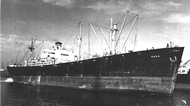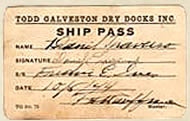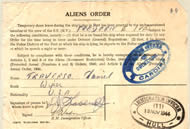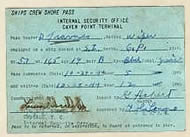Voyage Six
SS Frederic E. Ives - Page 1
Of course I didn't know what the Captain of the Cape Falcon had written or done when I boarded the SS Frederic E. Ives, a new Liberty Ship just of the Todd Shipyard's ways in Houston, Texas on October 5, 1944. But I figured that he had made a complaint with the Coast Guard. Curtis Hurst had hitch-hiked home with me and we quickly signed on this ship together. We figured if they came looking for us, we might as well be at sea or better overseas. Curtis was shipping Fireman/Water Tender and I signed on as Wiper. That was my first voyage as part of the "black gang", the engine room crew. The term comes from coal-fired steamship days when the engine room crew always came off watch covered in coal dust. Mike LaSoya, who I had shipped with before was Bos'n. Another of the Firemen was a guy from Galveston, George "Buddy" Jordan. I knew who Buddy was but I was from the East End and he was from the West End of Galveston Island and we really didn't know each other well before sailing together. We would become friends and ship together a couple of more times. During this trip Buddy Jordan taught me how to fire the engines. I sometimes stood his watch for him when he wanted to go ashore.
One of the engine crew, who I won't name, was crazy about a girl in Galveston. I stood his watches and covered for him so he could spend time with her while we were fitting out and loading. He said he was in love with her. But on the way to New York he came down with the clap. Jesus, he was pissed and got to be almost impossible to be around. He kept going on and on about how much he cared for this girl and she had lied to him; and how he thought she was a nice girl but she was obviously sleeping around. I was getting sick hearing about it. One day he was going on about how she had betrayed him and he let slip her name. Was I surprised. I had grown up with this girl. Her father was in the fire department with my dad. I told him if he thought she had betrayed him, how about her husband. My friend was stunned because he thought that she was single. No, I told him that she was married and her husband was a nice guy off in the Army in the Pacific. They were both friends of mine and it was her husband who was getting the crummy deal. After that he sort of calmed down and started to get over her. He didn't want to get his V.D. treated but we made him go see a doctor when we got to New York.
The Frederic E. Ives was several days in Houston being outfitted with armaments and degaussing cable (anti-magnetic mine defense), and loading cargo. ( The Armed Guard Report of Lt. (JG) John Conrad states "that type of cargo, high explosives for Army" and that "one day delay occurred at Houston Texas to repair broken rivet in plate caused by being rammed by tug. " The report also states that the Ives sailed alone from Houston to New York. )
The Ives sailed from Houston 10/20/44 and arrived at New York on 10/27/44 and took on deck cargo and then joined a convoy of thirty eight ships and four escorts for the crossing to England. The Ives sailed down through the Irish Sea with a group of ships headed for the Mersey. The Ives was detached and sailed South around Land's End and then up the English Channel. The Ives arrived at Southend, England on 11/13/1944 and sailed the next day in company of thirty nine other vessels and two escorts up the English Channel for Hull, England. The Ives arrived at Hull on November 15, 1944 and remained there until December 1, 1944. ( The day after the Ives docked another Liberty ship bound for Hull struck a mine approaching the Humber River and was severely damaged but managed to be towed into port for Hull. )
I liked Hull. Next to Manchester, Hull was my favorite port of call in England, though it was winter, cold, foggy and wet. The damp cold weather just cut right through my peacoat and clothes, but the people and the bars I remember as very warm in Hull. We were in port more than two weeks and I remember very much enjoying my time there.I made friends with a U.S. Navy sailor off a destroyer that I met in a pub. He worked in the engine room on the destroyer and was curious about a Liberty Ship as he had never been on one. I took him aboard the Ives and down into the engine room. He wanted to know how many of us were down there when we were firing the engines and I said three of us, ( four if a cadet was aboard ). He couldn't believe that three men could run such a big ship. I forgot how many men he said were on duty in his destroyer's engine room, maybe fifteen - it was a slew of them. He said they had several firemen. I asked him what the hell they did and he said each had a particular little job to do watching a particular gauge or turning a specific valve. Jesus, I said, they could save a lot of Navy lives if they didn't have so many men on their ships. He said there were more than three hundred on his destroyer and he couldn't believe that just forty men ran our ship. We had a lot of work to do because there were so few of us. A Liberty Ship is several times bigger than a destroyer and the usual crew was between 37 - 41 men. The U.S. Merchant Marine hauled hundreds of millions of tons of war supplies and millions of troops with what was really a pretty small force of seamen. They said that about 6000 U. S. ships were manned by only 215,000 merchant seamen during the war. From what I could see, the guys on Navy ships were falling over each other.




